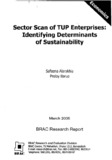Sector scan of TUP enterprises: identifying determinants of sustainability
Citation
Alarakhia, S., & Barua, P. (2005, March). Sector scan of TUP enterprises: identifying determinants of sustainability. Research Reports (2005): Economic Studies, Vol - XXIII, 90–156.Abstract
A key objective of the CFPR-TUP programme to assist the ultra poor is the development of sustainable
livelihoods, through the transfer of assets and skills to specially targeted ultra poor members for income
generation. During the pilot phase of the programme between 2002-03, six enterprises were selected to
offer to TUP members - cage rearing of poultry, dairy cow rearing, goat rearing, vegetable cultivation,
horticulture nursery and non-farm enterprises. The sector scan of TUP enterprises is a comprehensive
study comparing and evaluating the selected TUP enterprises on key criteria that relate to enterprise
sustainability - the likelihood that TUP members will continue operating the enterprise after the
withdrawal of BRAC programme support. The range of enterprises offered to TUP members differ in some important ways. These
differences affect the ability of TUP members to sustain the enterprises, based on their individual,
household and social circumstances. Enterprise specific characteristics such as risk and investment
needs, and to a lesser extent time, skill and labour requirements are principle factors determining the
likelihood of TUP members continuing with a given enterprise over the long term. Specifically,
enterprises with combined characteristics of high risk and high investment costs, such as cage rearing of
poultry and vegetable cultivation, were found to be sustainable by only a small percentage of TUP
members who were initially allocated these enterprises. On the other hand, low risk enterprises, low cash
investment enterprises such as cow rearing for which the main investment was time and labour, rather
than cash, were found to be highly sustainable. Risk was found to be a key factor determining enterprise profitability. Projected enterprise
economics, detailing expected costs and revenues and hence income available for consumption
generated by TUP enterprises, typically overestimated profitability. The difference appears to be
explained largely by enterprise related risks that occur in practice as TUP members operate their
respective enterprises, and reduce profitability. External risks, outside the control of TUP members, such
as weather and local market conditions, were found to be key risks in the agriculture based enterprises.
In the case of livestock enterprises, internal risks, stemming from TUP actions, were found to be of
primary importance. For example, a key factor constraining profits from cow and goat rearing was the
inability of TUP to properly feed livestock due to a lack of access to grazing land reducing their value
and output. Factoring in these risks changes the picture of the income TUP enterprises are likely to
generate and their relative attractiveness as ongoing sources of income...

